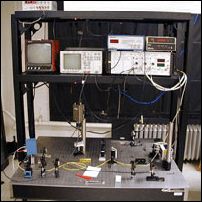Description

Spectroscopy experiment device.
Traditionally, optical spectroscopy had been performed by dispersing the light emitted by excited matter, or by dispersing the light transmitted by an absorber. Alternatively, if one has available a tunable monochromatic source (such as certain lasers), a spectrum can be measured one wavelength at a time by measuring light intensity (fluorescence or transmission) as a function of the wavelength of the tunable source.
In either case, physically important structures in such spectra are often obscured by the Doppler broadening of spectral lines that comes from the thermal motion of atoms in the matter. In this experiment you will make use of an elegant technique known as Doppler-free saturated absorption spectroscopy that circumvents the problem of Doppler broadening. The primary experimental objective will be to use this technique to measure the hyperfine splittings in the S1/2 and P1/2 it about lasers in general and diode lasers in particular.
Lab Guide
Doppler-Free Laser Spectroscopy Lab Guide (PDF)
References
Feld, M. S., and V. S. Letokhov. " Laser Spectroscopy (PDF)." Scientific American 229 (Dec. 1973): 69-85.
Laser Spectroscopy (PDF)." Scientific American 229 (Dec. 1973): 69-85.
Letokhov, V. S. "Saturation Spectroscopy." Chapter 4 in Topics in Applied Physics, Edited by K. Shimoda. Berlin: Springer, 1976, pp. 95-171.
Letokhov, V. S., and V. P. Chebotayev. Nonlinear Laser Spectroscopy. Vol. 4, Springer Series in Optical Sciences. New York, NY: Springer-Verlag, 1977, pp. 1-35. ISBN: 9780387080444.
Woodgate, G. K. "Hyperfine Structure and Isotope Shift." Chapter 9 in Elementary Atomic Structure. Oxford: Oxford University Press, 1983, pp. 168-187. ISBN: 9780198511564.
Pappas, P. G., et al. "Saturation Spectroscopy with Laser Optical Pumping in Atomic Barium." The Physical Review 21A, no. 6 (1980): 1955-1968.
Aminoff, C. and M. Pinard. "Velocity Selective Optical Pumping." J Physique 43 (1982): 263-277.
Nakayama, S. "Theoretical Analysis of Rb and Cs D2 Lines in Saturation Spectroscopy with Optical Pumping: Part I." Journal of the Physical Society of Japan 23, no. 7 (1984): 879-883.
———. "Theoretical Analysis of Rb and Cs D2 Lines in Doppler-Free Spectroscopic Techniques with Optical Pumping: Part II." Journal of the Physical Society of Japan 24, no. 1 (1985): 1-7.
———. "Velocity Selective Optical Pumping Spectroscopy of D1 Lines in Alkali Atoms." Journal of the Physical Society of Japan 53 (1984): 3351-3361.
Camparo, J. C. "The Diode Laser in Atomic Physics." Contemporary Physics 26, no. 5 (1985): 443-477.
Brandenberger, J. R. "Hyperfine Splittings in 4p5 5p Configuration of (83)Kr using Saturated Absorption Laser Spectroscopy." The Physical Review A 39, no. 1 (January 1989): 64-68.
Wieman, C. E., and L. Hollberg. "Using Diode Lasers for Atomic Physics." The Review of Scientific Instruments 62, no. 1 (1991): 1-20.
MacAdam, K. B., A. Steinbach, and C. Wieman. "A Narrow‐band Tunable Diode Laser System with Grating Feedback, and a Saturated Absorption Spectrometer for Cs and Rb." American Journal of Physics 60, no. 12 (1992): 1098-1111.
Steck, D. " Rubidium 87 D Line Data (PDF)." Los Alamos Theoretical Division (T-8). September 2001.
Rubidium 87 D Line Data (PDF)." Los Alamos Theoretical Division (T-8). September 2001.
